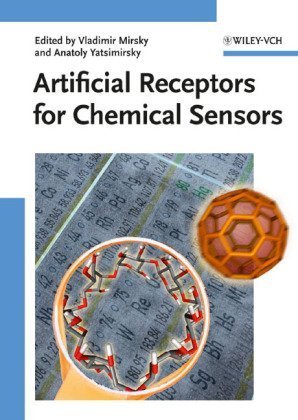(Ebook PDF) Artificial Receptors for Chemical Sensors 1st Edition by Vladimir Mirsky, Anatoly Yatsimirsky ISBN 3527632506 9783527632503 full chapters
$50.00 Original price was: $50.00.$35.00Current price is: $35.00.
(Ebook PDF)Artificial Receptors for Chemical Sensors 1st Edition by Vladimir Mirsky, Anatoly Yatsimirsky -Ebook PDF Instant Download/Delivery:3527632506, 9783527632503
Instant download Full Chapter of Artificial Receptors for Chemical Sensors 1st Editionafter payment

Product details:
ISBN 10:3527632506
ISBN 13: 9783527632503
Author: Vladimir M. Mirsky, Anatoly Yatsimirsky
Table of Contents:
QUANTITATIVE CHARACTERIZATION OF AFFINITY PROPERTIES OF IMMOBILIZED RECEPTORS
Introduction
Measurements Under Equilibrium Conditions
Kinetic Measurements
Analysis of Temperature Dependencies
Experimental Techniques
SELECTIVITY OF CHEMICAL RECEPTORS
Introduction
Some General Considerations on Selectivity
Correlation Between Selectivity and Affinity
Crown Ether and Cryptand Complexes: Hole Size Fitting and Other Effects
Recogniction of Transition and Heavy Metal Ions
Recognition via Ion Pairing
Hydrogen Bonded Complexes and Solvent Effects
Lewis Acid Receptors
Complexes with Stacking and van der Waals Interactions
Multifunctional Receptors for Recognition of Complex Target Molecules
Conclusions
COMBINATORIAL DEVELOPMENT OF SENSING MATERIALS
Introduction
General Principles of Combinatorial Materials Screening
Opportunities for Sensing Materials
Designs of Combinatorial Libraries of Sensing Materials
Discovery and Optimization of Sensing Materials Using Discrete Arrays
Optimization of Sensing Materials Using Gradient Arrays
Emerging Wireless Technologies for Combinatorial Screening of Sensing Materials
Summary and Outlook
FLUORESCENT CYCLODEXTRINS AS CHEMOSENSORS FOR MOLECULE DETECTION IN WATER
Introduction
Pyrene-Appended Cyclodextrins
Fluorophore-Amino Acid-CD Triad Systems
Molecular Recognition by Regioisomers of Dansyl-Appended CDs
Turn-On Fluorescent Chemosensors
Effect of Protein Environment on Molecule Sensing
CD-Peptide Conjugates as Chemosensors
Immobilized Fluorescent CD on a Cellulose Membrane
Conclusion
CYCLOPEPTIDE DERIVED SYNTHETIC RECEPTORS
Introduction
Receptors for Cations
Receptors for Ion Pairs
Receptors for Anions
Receptors for Neutral Substrates
Conclusion
BONORIC ACID-BASED RECEPTORS AND CHEMOSENSORS
Introduction
De Novo Design
Combinatorial Approaches
Template Directed Synthesis
ARTIFICIAL RECEPTOR COMPOUNDS FOR CHIRAL RECOGNITION
Introduction
Cyclodextrins
Crown Ethers
Calixarenes
Calix[4]resorcinarenes
Miscellaneous Receptor Compounds
Metal-Containing Receptor Compounds
FULLERENE RECEPTORS BASED ON CALIXARENE DERIVATIVES
Introduction
Calixarenes
Solid State Complexation by Calixarenes
Comlexation in Solution
Calixarenes as Molecular Scaffolds
Outlook
GUANIDINIUM BASED ANION RECEPTORS
Introduction
Instructive Historical Examples
Recent Advances in Inorganic Anion Recognition
Organic and Biological Phosphates
Polycarboxylate Binding
Amino Acid Recognition
Dipeptides as Substrate
Polypeptide Recognition
Conclusion
ARTIFICIAL RECEPTORS BASED ON SPREADER-BAR SYSTEMS
POTENTIAL OF APTAMERS AS ARTIFICIAL RECEPTORS IN CHEMICAL SENSORS
Introduction
Generation and Synthesis of Aptamers
Aptamer Arrays
Techniques for Readout of Ligand Binding to the Aptamer
Outlook/Summary
CONDUCTING POLYMERS AS ARTIFICIAL RECEPTORS IN CHEMICAL SENSORS
Introduction
Transducers for Artificial Receptors Based on Conducting Polymers
Intrinsic Sensitivity of Conducting Polymers
Conducting Polymers Modified with Receptor Groups
Conclusion
MOLECULARLY IMPRINTED POLYMERS AS ARTIFICIAL RECEPTORS
Introduction
Fundamentals of Molecular Imprinting
Polymer Formats and Polymerization Methods for MIPs
Evaluation of MIP Performance –
Imprinting Efficiency
MIPs Mimicking Natural Receptors
Conclusions and Outlook
QUANTITATIVE AFFINITY DATA ON SELECTED ARTIFICIAL RECEPTORS
Structures of Receptors
People also search:
artificial chemotaxis
chemical sensory receptors
chemical receptors examples
chemical receptor
chemical receptors definition
Tags:
Artificial Receptors,Chemical Sensors,Vladimir Mirsky,Anatoly Yatsimirsky


